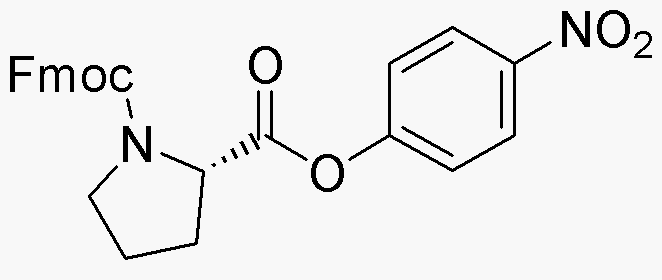Fmoc-L-proline 4-nitrophenyl ester is widely utilized in research focused on:
- Peptide Synthesis: This compound serves as a protecting group in the synthesis of peptides, allowing for selective reactions without interfering with other functional groups. Its stability under various conditions makes it a preferred choice for chemists.
- Drug Development: In pharmaceutical research, it aids in the design of new drugs by facilitating the formation of complex peptide structures, which can lead to more effective therapeutic agents.
- Bioconjugation: The compound is used in bioconjugation processes, where it helps attach biomolecules to surfaces or other molecules, enhancing the functionality of biosensors and drug delivery systems.
- Research in Protein Engineering: It plays a crucial role in modifying proteins to study their structure and function, providing insights that are essential for developing new biotechnological applications.
- Analytical Chemistry: Fmoc-L-proline 4-nitrophenyl ester is utilized in analytical methods to improve the detection and quantification of amino acids and peptides, offering higher sensitivity and specificity compared to traditional methods.
General Information
Properties
Safety and Regulations
Applications
Fmoc-L-proline 4-nitrophenyl ester is widely utilized in research focused on:
- Peptide Synthesis: This compound serves as a protecting group in the synthesis of peptides, allowing for selective reactions without interfering with other functional groups. Its stability under various conditions makes it a preferred choice for chemists.
- Drug Development: In pharmaceutical research, it aids in the design of new drugs by facilitating the formation of complex peptide structures, which can lead to more effective therapeutic agents.
- Bioconjugation: The compound is used in bioconjugation processes, where it helps attach biomolecules to surfaces or other molecules, enhancing the functionality of biosensors and drug delivery systems.
- Research in Protein Engineering: It plays a crucial role in modifying proteins to study their structure and function, providing insights that are essential for developing new biotechnological applications.
- Analytical Chemistry: Fmoc-L-proline 4-nitrophenyl ester is utilized in analytical methods to improve the detection and quantification of amino acids and peptides, offering higher sensitivity and specificity compared to traditional methods.
Documents
Safety Data Sheets (SDS)
The SDS provides comprehensive safety information on handling, storage, and disposal of the product.
Product Specification (PS)
The PS provides a comprehensive breakdown of the product’s properties, including chemical composition, physical state, purity, and storage requirements. It also details acceptable quality ranges and the product's intended applications.
Certificates of Analysis (COA)
Search for Certificates of Analysis (COA) by entering the products Lot Number. Lot and Batch Numbers can be found on a product’s label following the words ‘Lot’ or ‘Batch’.
*Catalog Number
*Lot Number
Certificates Of Origin (COO)
This COO confirms the country where the product was manufactured, and also details the materials and components used in it and whether it is derived from natural, synthetic, or other specific sources. This certificate may be required for customs, trade, and regulatory compliance.
*Catalog Number
*Lot Number
Safety Data Sheets (SDS)
The SDS provides comprehensive safety information on handling, storage, and disposal of the product.
DownloadProduct Specification (PS)
The PS provides a comprehensive breakdown of the product’s properties, including chemical composition, physical state, purity, and storage requirements. It also details acceptable quality ranges and the product's intended applications.
DownloadCertificates of Analysis (COA)
Search for Certificates of Analysis (COA) by entering the products Lot Number. Lot and Batch Numbers can be found on a product’s label following the words ‘Lot’ or ‘Batch’.
*Catalog Number
*Lot Number
Certificates Of Origin (COO)
This COO confirms the country where the product was manufactured, and also details the materials and components used in it and whether it is derived from natural, synthetic, or other specific sources. This certificate may be required for customs, trade, and regulatory compliance.

